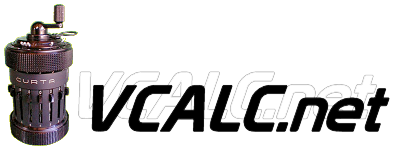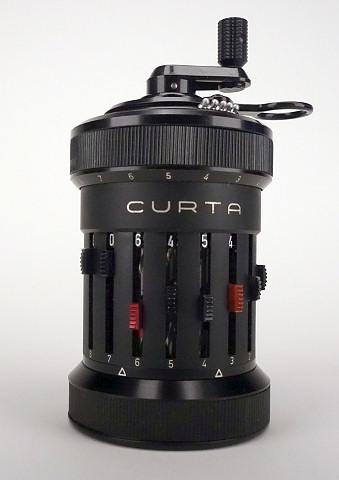Why was the CURTA 1a developed?
In order to understand why the Curta 1a was developed, it is beneficial to know a few points in the history of CONTINA AG:
In 1947, CONTINA AG - initially quartered in an inn in Mauren, Liechtenstein - began the development and production of the first 12 CURTA-samples, as they later appeared on the market.
In 1948, regular production started in the newly built plant; by mid-1950, about 700 pieces had been manufactured, with great difficulties (insufficient tools, machines, insufficient precision of the parts, and lack of well-trained personnel). The planned production volume was not reached by far: the material costs, assembly and control costs were too high, a lot of manual adjustments and testing was necessary.
The production costs in 1951 per CURTA: material CHF 155, labor CHF 103 (total 16 hours of labor).
These costs are estimated, an operational accounting - financial control did not exist in the beginning.
The customer paid retail CHF 215.
The CURTA was a loss-making business in the first years.
Curt Herzstark left the CONTINA AG company at the end of 1950. However, he remained associated with the company as a consultant until 1956.
During this time, the manufacturing costs could be reduced to CHF 210.
With the departure of Curt Herzstark, the company lost its competent technical leadership.
In 1955, the CURTA1 cost CHF 400 in retail, the CURTA2 CHF 495.
These sales prices remained constant (!) until 1970.
In 1957-58, a recession paralyzed the entire world economy, and CURTA sales dropped sharply. Other products (gramophones, photo/film cameras) were developed and produced. In 1960, business figures improved again, but CURTA production was no longer a priority.
Elmar Maier, mechanical engineer and co-designer of the CURTA1, was assigned to further develop the CURTA in order to reduce manufacturing costs. Some improvements led to new patents. A sample series of about 50 pieces of CURTA 1a was produced and tested at customers and in schools.
What improvements were made to the CURTA 1a?
- Crank made from DELRIN (cheaper to manufacture/assemble).
- DELRIN clearing lever (cheaper, more robust (the aluminum clearing lever often broke off
when the CURTA rolled away from the work surface and fell down)
- simplified stepped drum (assembly time halved)
- new decimal carryover mechanism (new mechanism, less parts, easier assembly)
- counter body made of zinc die casting, with injected register spindles (cheaper, less assembly
time)
- figure rollers made of DELRIN (cheaper, easier assembly)
- different production process for the setting spindle spiral grooves (90% less cost (rolled
instead of milled?)
- simple grooves instead of knurling at carriage-ring and bottom, plastic instead of aluminum
(cheaper)
- decimal marker on setting dial: replaced by rotating ring with engraved symbols, and plastic
control knob (cheaper, less parts, easier mounting)
- battery-electric drive, as an optional extra (outside of CURTA 1a)
Why were the improvements not implemented?
In 1961, the project was presented to the management.
A cost saving potential of 40% was shown.
Additional necessary investment costs: CHF 70,000 for tools, machinery, etc.
The management rejected the implementation of these improvements.
The project was stopped.
The reasons were not communicated.
Looking at the business environment of CONTINA AG at that time, the following reasons are likely for the negative decision:
- The company was fully committed to the camera technology, the necessary money was
needed for the film camera development
- feared difficulties in the introduction of production, with a collapse in production figures,
analog to 1948-1950
- the CURTA's were firmly and stably positioned in the market, no real competition could be
seen, so changes did not seem imperative.
- The only possible competitor was the ALPINA calculating machine, which came on the market in 1960. It was quite a bit larger, had a removable base, was more cumbersome to operate without the base, and, like the Curta 1948, had to fight with major production shortcomings. Production and sales were discontinued as early as 1961.
What happened next?
The CURTA 1a project was not completely in vain:
- the crank handle made of DELRIN was introduced, as well as the DELRIN clearing lever.
- The aluminum label on the canister replaced the engravings.
I don't know exactly when the plastic canister was introduced; the first CURTA in my collection with a plastic canister is from 1965.
(Note from Rick: I have a picture of a type I with a plastic case, serial #49815 that dates to 1962 and a type II with a plastic case, serial #532511 that dates to 1965)
Summary
Over the entire production period from 1948 to 1970 - 22 years! - very little was changed in the design; although technology produced many new and successful methods and materials, almost none of it was used. The CURTA 1a project was a bit of an exception to the rule here.
I think it has been good for CURTA.
The separation of Curt Herzstark and CONTINA AG was painful for both sides. He certainly could have contributed a lot to the further success of CURTA. There are many reasons for his departure, and have a long history.
But that is material for another report . . .
- - - - -
This report is based primarily on research on the Internet, and the books:
- Kein Geschenk für den Führer - Schicksal eines begnadeten Erfinders ("No Gift for the Leader - destiny of a gifted inventor")
- Curta, Carena & Co. - Geschichte der Contina in Mauren ("History of the Contina in Mauren")
Curta 1A Report
Also from Robert:
Here's a report published by ETH Zurich, written by Herbert Bruderer and Elmar Maier.
Among other things, they describe in detail the inner workings of the Curta 1a, with detailed photos, construction drawings, patent specifications, etc.
The report is in German, but the interesting images are easy to understand for English speakers.





